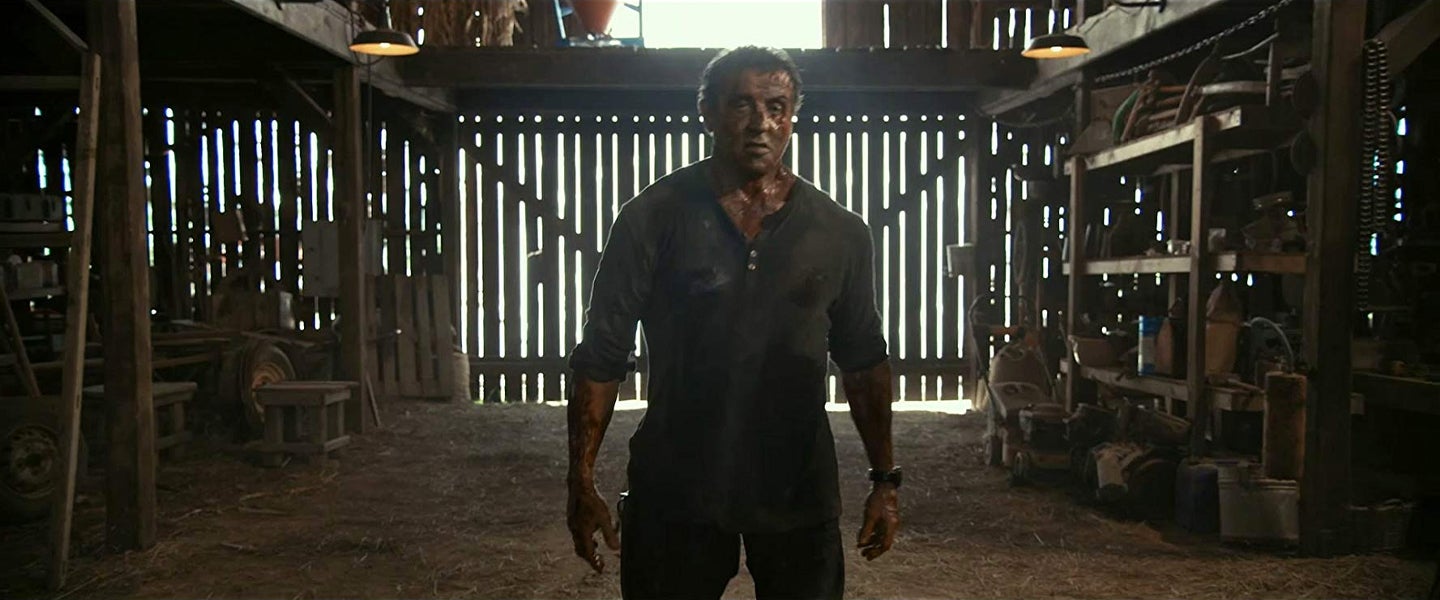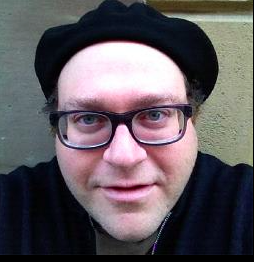The expression “mission creep” ought to be recognizable to a Vietnam vet like John J. Rambo. While the first installment in the Sylvester Stallone mega-franchise, 1982’s First Blood, is for sure an action-heavy and violent survivalist’s tale, it’s still rooted in some semblance of characterization and drama.
Stallone’s anti-authoritarian one-man-army was a psychologically tormented drifter, prone to flashbacks and paranoia. All he wants is to mourn his fallen comrade (a delayed Vietnam casualty from Agent Orange) and be left in peace, but The Man forever has Rambo in its sights: Battle is his birthright, and persecution from larger forces is the albatross around his neck. As such, destiny leads him to booby trap a section of Pacific Northwest woods, destroy a helicopter and jump through a police station roof to secure his safety.
If Rambo’s drift into this small town led to “mission creep” (blowing the place up), one could argue the same happened to the franchise itself. Let’s call it “genre creep”: No one would ever confuse First Blood with a prestige drama (hell, it’s no F.I.S.T.!) but compared to the Rambo sequels, it’s practically a Merchant-Ivory production.
Rambo: First Blood Part II came out in 1985, dismissing most of what made First Blood human and sending Rambo-as-killing-machine back to Vietnam on a secret mission to find remaining POWs. It was an international sensation — “What mean expendable?” all the kids were asking on the schoolyard (okay, that part’s not technically true, but rampaging around the jungle gym pretending to fire a compound bow with explosive arrow tips while making low growls definitely increased in popularity after the movie came out).
Despite a distrust of government being core to his character, Rambo was praised by President Ronald Reagan, dovetailing neatly with Stallone’s own conservative politics. Rambo III (1988) placed Rambo in Afghanistan fighting Commies alongside the Mujahideen, so if you want to suggest that this series helped create Al Qaeda, I’m not going to stop you (the film was even dedicated to “the gallant people of Afghanistan”). Either way, it was a long, long way from that tense-but-borderline realistic first film — a film in which, let’s not forget, Rambo committed suicide in the original ending — from back in 1982.
The violence in the Rambo franchise turned truly grotesque with the revival in 2008. Rambo (oh, the naming structure of this series!) opens with teen sex slaves and gets queasier from there (you can click this link if you want to know what it looks like when Sylvester Stallone rips out a guy’s throat). Heaven only knows what’s coming up in the new Rambo: Last Blood, but one thing to remember is that Rambo’s achievement of genre creep went two ways. While the newer films may rival the roughest slashers, back in 1986 John Rambo also had his targets set on the after-school cartoon audience. Likely conceived as an alternative to the extremely popular G.I. Joe: A Real American Hero, a surprising 65 episodes of Rambo: The Force of Freedom were produced. Gaze upon the animated shirtless Sly!
Just as Rambo turns any foe and his materiel to cinders, no other franchise has mastered the genre creep quite the way he has. But that hasn’t kept others from trying. For instance, there’s also…
Mad Max
A strong contender for the prize would be Max Rockatansky, who, in George Miller’s 1979 picture Mad Max, was merely a highway patrolman in the “near future,” zooming along the desert wearing leather pants. Compare that to the character laced up as a “blood bag” in 2015’s Mad Max: Fury Road, as Nux and his War Boys ride shiny and chrome into battle while the Doof Warrior swings from an amp-covered truck, spewing flames from his powerchord-ripping electric guitar.
Seriously, how did we get from the first movie to that? The answer, as with so much, is baby-steps. While the first film showed that society was starting to break down somewhat due to unknown forces, The Road Warrior and Mad Max Beyond Thunderdome edged the series into full-on post-apocalyptic fantasy. First it was a monster of a man called The Lord Humungus in metal underwear and a mask that’s half-hockey goalie, half cover of a Quiet Riot album, and then, naturally, Tina Turner. Two men enter, one man leaves!
Babe
I guess there’s something about George Miller. The Australian auteur (and former doctor) who wrote and directed the Mad Max films (and, uncharacteristically, the tear-jerker Lorenzo’s Oil), produced and co-scripted the surprise hit Babe, an adorable kiddie film about a pig who behaved like a sheep-dog and said things like, “I want my mom.”
It’s a terrific little movie set on a farm that won hearts because it was simple. “That’ll do, pig!” indeed. And then came Babe: Pig in the City, this time directed by Miller himself, and everything went completely insane.
More of a spirit of, say, The LEGO Movie, the high-energy sequel shakes off all the calm and down-home docility of the original for eye-popping action. Sure, the original Babe wasn’t exactly big on realism, but it’s Au Hasard Balthazar (to keep this all-barnyard) compared to Babe: Pig in the City. The film is set in a mashup metropolis (a little Venice, a little New York, a little Terry Gilliam’s Brazil) and follows a haywire plot involving smuggling, larceny and class warfare. There’s even, as you can see in the clip above, a callback to Max Mad 3’s infamous Thunderdome bungee fight.
Ash Williams
Sam Raimi’s original The Evil Dead was released in 1981, at the apex of the post-Friday the 13th slasher craze. You had your My Bloody Valentine, your Happy Birthday to Me and your Hell Night coming out around the same time, but The Evil Dead differentiated itself with a bit of supernaturalism (the Book of the Dead) and gruesome trees that committed sex crimes. But it also, if one was tuned to its wavelength, had something of a sense of humor encoded into its DNA, manifesting itself not in plot or even dialogue, but in the playful, somewhat comic book panel style of its shot framing and camera movements.
But still, it was more horror than comedy. When Evil Dead 2: Dawn of the Dead came around (already notable for being almost more of a remake than a sequel), this element got amped up, catering the franchise more to the campy Elvira-and-Rocky Horror crowd than the gorehounds. For part three, Army of Darkness (sometimes called Medieval Dead), Bruce Campbell’s leading jaw, uh, man, Ash, went back in time to a Middle Earth-like realm of sword and sorcery to battle skeletons and rescue princesses in a full-on, large scale comedy.
The franchise took a pause here (1992) but picked up steam as the series Ash vs Evil Dead in 2015, leaning even more heavily on the slapstick and comedy.
Frankenstein
Genre creep, thy name is Frankenstein. As we noted recently, James Whale’s 1931 film Frankenstein, one of the most important horror films of all time, began its life as Mary Wollstonecraft Shelley’s Romantic novel from 1818 (written when she was just 18). Its primary drive is Dr. Frankenstein’s refusal to accept the death of his mother. Shelley’s version of the Creature is articulate and cunning, and not stitched together from numerous body parts “like a Frankenstein.”
Of note: Shelly’s novel is in the public domain, but depictions of a green-hued giant with bolts in its neck is the intellectual property of Universal Pictures thanks to Whale’s electro-gothic film version. The Bride of Frankenstein (1935), which Whale also directed, continued in this mold (and is one of the few sequels that may even be better than the original).
The franchise grew with Son of Frankenstein in 1939, and while far from a masterpiece, Rowland V. Lee’s film is still in the same aesthetic ballpark. Things quickly got dumb with The Ghost of Frankenstein in 1942, then the floodgates of the Universal Horror titles (an early “cinematic universe”) opened up. Frankenstein Meets The Wolfman and House of Frankenstein, among others, involved crossovers with other monsters until the humiliating conclusion of this run, the dopey kid-friendly comedy Abbott and Costello Meet Frankenstein in 1948.
007
Let’s close this out with a tale of redemption. Sean Connery’s depiction of James Bond, first introduced in Dr. No (1962), was a suave man of action who was quick on his feet and with the ladies. Plus, he looked damn good in a tux. You can say the same exact thing about Daniel Craig’s version, currently wrapping up No Time To Die, due out next year.
But for a few years, things veered pretty wildly off track. Not to knock Roger Moore, who made some really good ones — I’d argue that For Your Eyes Only (1981) is top-level Bond, right up there with From Russia With Love (1963) and Skyfall (2012) — but just what the hell was going on around 1979 with entries like Moonraker? James Bond belongs in a casino, not in outer space. And so, most would agree it’s good to see that he’s come back down to Earth.

